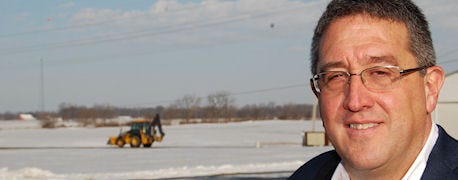March 11, 2014

Scott Shearer, chair of the Department of Food, Agricultural and Environmental Engineering at Ohio State, offered his view of technology and its impact on agriculture to a mixed group of business folks and farmers recently in Lancaster. In machine-gun fashion Shearer raced through the new developments in farming with comments on their impact.
The presentation was real eye-opener for the attendees especially those who were not familiar with agriculture. "Wow, I had no idea how far we had come in farming," I was told by one of the employees of Fairfield National Bank, which sponsored the breakfast meeting. "The way agriculture is using technology now and what is on line is mind blowing."

TECH TALK: Scott Shearer, chair of OSU Department of Food, Agricultural and Environmental Engineering, says Internet technology and data enables he and his grad students to know more about what is going on in the demonstration fields at Farm Science Review than manager Chuck Gamble.
Shearer opened his comments by noting how the new Google Glass technology might benefit him personally. "If I could take a photo and have that face immediately identified on the lens, I wouldn't be struggling to remember everyone's name."
Such data analysis is beginning to change the face of farming, Shearer said. For farmers it will mean looking at a diseased crop leaf and immediately knowing what the problem is and what to do to help it. When it comes to planting farmers will be able to instantly analyze soil and climate data to decide what hybrids to plant at what populations.
"Monsanto, the company everyone loves to hate, used to be a chemical company. Now it is known for genetics," he said.
Big Data is driving precision planting Shearer told the group. "All kinds of steps are being taken to improve emergence. Planting depth is crucial. We want all the seeds to emerge within 12 to 24 hours of each other. Anything that comes up later is just a weed."
"We will go to the field with four or five different hybrids in the planter. What is planted where will depend on the landscape of the field."
Shearer cited Monsanto's recent acquisition of The Climate Corporation for $983 million "when it was valued at one third that, according to the Wall Street Journal " as proof of the value of data.
Data like the kind Climate Corp generates enables farmers to monitor field conditions precisely.
"With the data I can get, my team of engineers knows more about what's going on in the demonstration fields at Farm Science review than the show manager does," he said. "They take the radar weather information and determine soil moisture levels. Depending on the soil moisture we know what the optimal planting date is and what the planting population should be as well as which hybrids will perform best. We've basically taken the field over based on information derived on-line."
Similarly Shearer described the harvesting software that combines climate data to predict crop moisture levels and evaluate the best time to harvest. "With the multi-county farm operations of today that can be a tremendous benefit to scheduling activities in the fall."
Here are some of the other high-tech shockers Shearer offered up:
•New John Deere planter will run at 10 mph
•Aligning corn plant leaves perpendicularly in the row improves canopy and productivity by 1.4%
•Ohio State researchers have developed technology to orient the seed in the furrow.
•New hybrids boost corn stover production to feed cellulosic ethanol plants.
•Cell phone modems on the implements call the operator to tell him about mechanical problems.
•Auto steer is cheaper than a row marker on today's 48-row capacity planters.
•Equipment size is being limited by ability to transport it to the farm or dealer.
•Large equipment is also being limited by the size of the roads it must travel on to get to the field.
•Unmanned Aerial Vehicles or drones have great potential for farmers.
•Autonomous vehicles can already operate themselves on farms.
•The operating life of some today's farm equipment may far outpace its technological usefulness.
You May Also Like




